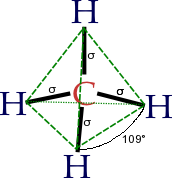Methane
| Methane | |
|---|---|
 |
 |
 |
 |
|
Other names
Methyl hydride, Marsh gas, biogas
|
|
| Identifiers | |
| CAS number | 74-82-8 |
| PubChem | 297 |
| ChemSpider | 291 |
|
SMILES
C
|
|
|
InChI
InChI=1/CH4/h1H4
|
|
| Properties | |
| Molecular formula | CH4 |
| Molar mass | 16.042 g/mol |
| Appearance | Colorless gas |
| Density | 0.717 kg/m3 (gas, 0 °C) 415 kg/m3 (liquid) |
| Melting point |
-182.5 °C, 91 K, -297 °F |
| Boiling point |
-161.6 °C, 112 K, -259 °F |
| Solubility in water | 35 mg/L (17 °C) |
| Hazards | |
| EU classification | Highly flammable (F+) |
| S-phrases | (S2), S9, S16, S33 |
| NFPA 704 |
 4
1
0
|
| Flash point | -188 °C |
| Explosive limits | 5 – 15% [1] |
| Related compounds | |
| Related alkanes | Ethane, propane |
| Related compounds | Methanol, chloromethane, formic acid, formaldehyde, silane |
| Except where noted otherwise, data are given for materials in their standard state (at 25 °C, 100 kPa) |
|
| Infobox references | |
Methane is a chemical compound with the chemical formula CH4. It is the simplest alkane, and the principal component of natural gas. Methane's bond angles are 109.5 degrees. Burning methane in the presence of oxygen produces carbon dioxide and water. The relative abundance of methane makes it an attractive fuel. However, because it is a gas at normal temperature and pressure, methane is difficult to transport from its source. In its natural gas form, it is generally transported in bulk by pipeline or LNG carriers; few countries transport it by truck.
Methane was discovered and isolated by Alessandro Volta between 1776 and 1778 when studying marsh gas from Lake Maggiore.
Methane is a relatively potent greenhouse gas. Compared with carbon dioxide, it has a high global warming potential of 72 (calculated over a period of 20 years) or 25 (for a time period of 100 years).[2] Methane in the atmosphere is eventually oxidized, producing carbon dioxide and water. As a result, methane in the atmosphere has a half life of seven years.
The abundance of methane in the Earth's atmosphere in 1998 was 1745 parts per billion (ppb), up from 700 ppb in 1750. By 2008, however, global methane levels, which had stayed mostly flat since 1998, had risen to 1,800 ppb[3]. By 2010, methane levels, at least in the arctic, were measured at 1850 ppb, a level scientists described as being higher than at any time in the previous 400,000 years.[4] (Historically, methane concentrations in the world's atmosphere have ranged between 300 and 400 ppb during glacial periods commonly known as ice ages, and between 600 to 700 ppb during the warm interglacial periods).
In addition, there is a large, but unknown, amount of methane in methane clathrates in the ocean floors. The Earth's crust contains huge amounts of methane. Large amounts of methane are produced anaerobically by methanogenesis. Other sources include mud volcanoes, which are connected with deep geological faults, landfill and livestock (primarily ruminants) from enteric fermentation.
Contents |
Properties
Methane is the major component of natural gas, about 87% by volume. At room temperature and standard pressure, methane is a colorless, odorless gas; the smell characteristic of natural gas as used in homes is an artificial safety measure caused by the addition of an odorant, often methanethiol or ethanethiol. Methane has a boiling point of −161 °C at a pressure of one atmosphere.[5] As a gas it is flammable only over a narrow range of concentrations (5–15%) in air. Liquid methane does not burn unless subjected to high pressure (normally 4–5 atmospheres).
Potential health effects
Methane is not toxic; however, it is highly flammable and may form explosive mixtures with air. Methane is violently reactive with oxidizers, halogens, and some halogen-containing compounds. Methane is also an asphyxiant and may displace oxygen in an enclosed space. Asphyxia may result if the oxygen concentration is reduced to below 19.5% by displacement . The concentrations at which flammable or explosive mixtures form are much lower than the concentration at which asphyxiation risk is significant. When structures are built on or near landfills, methane off-gas can penetrate the buildings' interiors and expose occupants to significant levels of methane. Some buildings have specially engineered recovery systems below their basements to actively capture such fugitive off-gas and vent it away from the building. An example of this type of system is in the Dakin Building, Brisbane, California.
Reactions of methane
Main reactions with methane are: combustion, steam reforming to syngas, and halogenation. In general, methane reactions are hard to control. Partial oxidation to methanol, for example, is difficult to achieve; the reaction typically progresses all the way to carbon dioxide and water.
Combustion
In the combustion of methane, several steps are involved:
Methane is thought to form a formaldehyde (HCHO or H2CO). The formaldehyde gives a formyl radical (HCO), which then forms carbon monoxide (CO). The process is called oxidative pyrolysis:
- CH4 + O2 → CO + H2 + H2O
Following oxidative pyrolysis, the H2 oxidizes, forming H2O, releasing heat. This occurs very quickly, usually in significantly less than a millisecond.
- 2 H2 + O2 → 2 H2O
Finally, the CO oxidizes, forming CO2 and releasing more heat. This process is generally slower than the other chemical steps, and typically requires a few to several milliseconds to occur.
- 2 CO + O2 → 2 CO2
The result of the above is the following total equation:
where bracketed "g" stands for gaseous form and bracketed "l" stands for liquid form.
Hydrogen activation
The strength of the carbon-hydrogen covalent bond in methane is among the strongest in all hydrocarbons, and thus its use as a chemical feedstock is limited. Despite the high activation barrier for breaking the C–H bond, CH4 is still the principal starting material for manufacture of hydrogen in steam reforming. The search for catalysts which can facilitate C–H bond activation in methane and other low alkanes is an area of research with considerable industrial significance. In oxidative coupling of methane the synthetic target is ethylene.
Reactions with halogens
Methane reacts with all halogens given appropriate conditions, as follows:
- CH4 + X2 → CH3X + HX
where X is a halogen: fluorine (F), chlorine (Cl), bromine (Br), or iodine (I). This mechanism for this process is called free radical halogenation. When X is Cl, this mechanism has the following form:
1. Radical generation:
The needed energy comes from UV radiation or heating,
2. Radical exchange:
- CH4 + Cl· → CH3· + HCl + 14 kJ
- CH3· + Cl2 → CH3Cl + Cl· + 100 kJ
3. Radical extermination:
- 2 Cl· → Cl2 + 239 kJ
- CH3· + Cl· → CH3Cl + 339 kJ
- 2 CH3· → CH3CH3 + 347 kJ
If methane and X2 are used in equimolar quantities, CH2X2, CHX3, and even CX4 are formed. Using a large excess of CH4 reduces the production of CH2X2, CHX3, CX4, and thus more CH3X is formed.
Uses
Fuel
- For more on the use of methane as a fuel, see natural gas
Methane is important for electrical generation by burning it as a fuel in a gas turbine or steam boiler. Compared to other hydrocarbon fuels, burning methane produces less carbon dioxide for each unit of heat released. At about 891 kJ/mol, methane's heat of combustion is lower than any other hydrocarbon but the ratio of the heat of combustion (891 kJ/mol) to the molecular mass (16.0 g/mol) shows that methane, being the simplest hydrocarbon, produces more heat per mass unit (55.7 kJ/g) than other complex hydrocarbons. In many cities, methane is piped into homes for domestic heating and cooking purposes. In this context it is usually known as natural gas, and is considered to have an energy content of 39 megajoules per cubic meter, or 1,000 BTU per standard cubic foot.
Methane in the form of compressed natural gas is used as a vehicle fuel, and is claimed to be more environmentally friendly than other fossil fuels such as gasoline/petrol and diesel.[6] Research into adsorption methods of methane storage for this purpose has been conducted.[7]
Research is being conducted by NASA on methane's potential as a rocket fuel.[8] One advantage of methane is that it is abundant in many parts of the solar system and it could potentially be harvested in situ (i.e. on the surface of another solar-system body), providing fuel for a return journey.[9]
Current methane engines in development produce a thrust of 7,500 pounds-force (33 kN), which is far from the 7,000,000 lbf (31 MN) needed to launch the Space Shuttle. Instead, such engines will most likely propel voyages from our moon or send robotic expeditions to other planets in the solar system.[10]
Recently methane emitted from coal mines has been successfully converted to electricity.[11]
Industrial uses
Methane is used in industrial chemical processes and may be transported as a refrigerated liquid (liquefied natural gas, or LNG). While leaks from a refrigerated liquid container are initially heavier than air due to the increased density of the cold gas, the gas at ambient temperature is lighter than air. Gas pipelines distribute large amounts of natural gas, of which methane is the principal component.
In the chemical industry, methane is the feedstock of choice for the production of hydrogen, methanol, acetic acid, and acetic anhydride. When used to produce any of these chemicals, methane is first converted to synthesis gas, a mixture of carbon monoxide and hydrogen, by steam reforming. In this process, methane and steam react on a nickel catalyst at high temperatures (700–1100 °C).
The ratio of carbon monoxide to hydrogen in synthesis gas can then be adjusted via the water gas shift reaction to the appropriate value for the intended purpose.
- CO + H2O → CO2 + H2
Less significant methane-derived chemicals include acetylene, prepared by passing methane through an electric arc, and the chloromethanes (chloromethane, dichloromethane, chloroform, and carbon tetrachloride), produced by reacting methane with chlorine gas. However, the use of these chemicals is declining. Acetylene is replaced by less costly substitutes, and the use of chloromethanes is diminishing due to health and environmental concerns.
Sources of methane for human use
Natural gas fields
The major source of methane is extraction from geological deposits known as natural gas fields. It is associated with other hydrocarbon fuels and sometimes accompanied by helium and nitrogen. The gas at shallow levels (low pressure) is formed by anaerobic decay of organic matter and reworked methane from deep under the Earth's surface. In general, sediments buried deeper and at higher temperatures than those which give oil generate natural gas. Methane is also produced in considerable quantities from the decaying organic wastes of solid waste landfills.
Alternative sources
Apart from gas fields, an alternative method of obtaining methane is via biogas generated by the fermentation of organic matter including manure, wastewater sludge, municipal solid waste (including landfills), or any other biodegradable feedstock, under anaerobic conditions. Methane hydrates/clathrates (ice-like combinations of methane and water on the sea floor, found in vast quantities) are a potential future source of methane. Cattle belch methane accounts for 16% of the world's annual methane emissions to the atmosphere.[12] The livestock sector in general (primarily cattle, chickens, and pigs) produces 37% of all human-induced methane.[13] Early research has found a number of medical treatments and dietary adjustments that help slightly limit the production of methane in ruminants.[14][15]
Industrially, methane can be created from common atmospheric gases and hydrogen (produced, for example, by electrolysis) through chemical reactions such as the Sabatier process, Fischer-Tropsch process. Coal bed methane extraction is a method for extracting methane from a coal deposit, while enhanced coal bed methane recovery is a method of recovering methane from an non-minable coal seam.
Scientific experiments have given variable results in determining whether plants are a source of methane emissions.[16][17][18]
Atmospheric methane

Methane is created near the Earth's surface, primarily in soils, rivers/seas and in animal innards. It is carried into the stratosphere by rising air in the tropics. Uncontrolled build-up of methane in the atmosphere is naturally checked — although human influence can upset this natural regulation — by methane's reaction with hydroxyl radicals formed from singlet oxygen atoms and with water vapor.
Methane in the Earth's atmosphere is an important greenhouse gas with a global warming potential of 25 compared to CO2 over a 100-year period (although accepted figures probably represents an underestimate[19]). This means that a methane emission will have 25 times the impact on temperature of a carbon dioxide emission of the same mass over the following 100 years. Methane has a large effect for a brief period (a net lifetime of 8.4 years in the atmosphere), whereas carbon dioxide has a small effect for a long period (over 100 years). Because of this difference in effect and time period, the global warming potential of methane over a 20 year time period is 72. The Earth's methane concentration has increased by about 150% since 1750, and it accounts for 20% of the total radiative forcing from all of the long-lived and globally mixed greenhouse gases.[20] Usually, excess methane from landfills and other natural producers of methane is burned so CO2 is released into the atmosphere instead of methane, because methane is such a more effective greenhouse gas. Recently, methane emitted from coal mines has been successfully utilized to generate electricity.
Arctic methane release from permafrost and clathrates is an expected consequence of global warming.[21]
In prehistoric times, large methane excursions have been linked with dramatic shifts in the Earth's climate, notably during the Paleocene-Eocene thermal maximum and during the Permian-Triassic extinction event, which was the worst ever mass extinction.
Extraterrestrial methane
Methane has been detected or is believed to exist in several locations of the solar system. It is believed to have been created by abiotic processes, with the possible exception of Mars.
- Moon – traces are outgassed from the surface[22]
- Mars – the atmosphere contains 10 ppb methane. In January 2009, NASA scientists announced that they had discovered that the planet often vents methane into the atmosphere in specific areas, leading some to speculate this may be a sign of biological activity going on below the surface.[23]
- Jupiter – the atmosphere contains about 0.3% methane
- Saturn – the atmosphere contains about 0.4% methane
- Uranus – the atmosphere contains 2.3% methane
- Ariel – methane is believed to be a constituent of Ariel's surface ice
- Miranda
- Oberon – about 20% of Oberon's surface ice is composed of methane-related carbon/nitrogen compounds
- Titania – about 20% of Titania's surface ice is composed of methane-related organic compounds
- Umbriel – methane is a constituent of Umbriel's surface ice
- Neptune – the atmosphere contains 1.6% methane
- Pluto – spectroscopic analysis of Pluto's surface reveals it to contain traces of methane[28][29]
- Eris – infrared light from the object revealed the presence of methane ice
- Comet Halley
- Comet Hyakutake – terrestrial observations found ethane and methane in the comet[31]
- Extrasolar planet HD 189733b – This is the first detection of an organic compound on a planet outside the solar system. Its origin is unknown, since the planet's high temperature (700 °C) would normally favor the formation of carbon monoxide instead.[32]
- Interstellar clouds[33]
See also
- 2007 Zasyadko mine disaster
- Abiogenic petroleum origin
- Anaerobic digestion
- Anaerobic respiration
- Arctic methane release
- Biogas
- Coal Oil Point seep field
- Greenhouse gas
- Halomethane, halogenated methane derivatives.
- List of alkanes
- Methanation
- Methane clathrate, form of water ice which contains methane.
- Methanogen, archaea that produce methane as a metabolic by-product.
- Methanogenesis, the formation of methane by microbes.
- Methanotroph, bacteria that are able to grow using methane as their only source of carbon and energy.
- Methyl group, a functional group similar to methane.
- Organic gas
- Thomas Gold
References
- ↑ MSDS Methane
- ↑ IPCC Fourth Assessment Report, Working Group 1, Chapter 2
- ↑ Carbon Dioxide, Methane Rise Sharply in 2007
- ↑ Methane seen as growing climate risk
- ↑ NIST Chemistry Webbook http://webbook.nist.gov/cgi/cbook.cgi?ID=C74828&Mask=4#Thermo-Phase
- ↑ Clayton B. Cornell (April 29, 2008). "Natural Gas Cars: CNG Fuel Almost Free in Some Parts of the Country". http://www.gas2.org/2008/04/29/natural-gas-cars-cng-fuel-almost-free-in-some-parts-of-the-country/. "Compressed natural gas is touted as the 'cleanest burning' alternative fuel available, since the simplicity of the methane molecule reduces tailpipe emissions of different pollutants by 35 to 97%. Not quite as dramatic is the reduction in net greenhouse-gas emissions, which is about the same as corn-grain ethanol at about a 20% reduction over gasoline"
- ↑ doi:10.1021/la0355500
This citation will be automatically completed in the next few minutes. You can jump the queue or expand by hand - ↑ Lunar Engines, Aviation Week & Space Technology, 171, 2 (13 July 2009), p. 16: "Aerojet has completed assembly of a 5,500-pound-thrust liquid oxygen/liquid methane rocket engine—a propulsion technology under consideration as the way off the Moon for human explorers"
- ↑ Methane Blast, NASA, May 4, 2007
- ↑ Green, V. (September). Hit the Gas: NASA's methane rocket could make long distance space travel possible, on the cheap. 271. Popular Science magazine. pp. 16–17. ISSN 0161-7370. http://books.google.com/?id=3AClY8pMg-EC&pg=PA16&lpg=PA16.
- ↑ A Global First: Coal Mine Turns Greenhouse Gas into Green Energy
- ↑ Miller, G. Tyler. Sustaining the Earth: An Integrated Approach. U.S.A.: Thomson Advantage Books, 2007. 160.
- ↑ "Livestock’s Long Shadow–Environmental Issues and Options". http://www.fao.org/docrep/010/a0701e/a0701e00.HTM. Retrieved 2009-10-27.
- ↑ New Zealand Tries to Cap Gaseous Sheep Burps
- ↑ Research on use of bacteria from the stomach lining of kangaroos (who don't emit methane) to reduce methane in cattle
- ↑ Hamilton JT, McRoberts WC, Keppler F, Kalin RM, Harper DB (July 2003). "Chloride methylation by plant pectin: an efficient environmentally significant process". Science (journal) 301 (5630): 206–9. doi:10.1126/science.1085036. PMID 12855805. http://www.sciencemag.org/cgi/pmidlookup?view=long&pmid=12855805.
- ↑ "Methane Emissions? Don't Blame Plants", ScienceNOW, 14 January 2009
- ↑ Plants do emit methane after all, New Scientist, 2 December 2007
- ↑ Shindell, D. T.; Faluvegi, G.; Koch, D. M.; Schmidt, G. A.; Unger, N.; Bauer, S. E. (2009). "Improved Attribution of Climate Forcing to Emissions". Science 326 (5953): 716. doi:10.1126/science.1174760. PMID 19900930.
- ↑ "Technical summary". Climate Change 2001. United Nations Environment Programme. http://www.grida.no/climate/ipcc_tar/wg1/017.htm.
- ↑ "Methane Releases From Arctic Shelf May Be Much Larger and Faster Than Anticipated". Press Release. National Science Foundation. http://www.nsf.gov/news/news_summ.jsp?cntn_id=116532&org=NSF&from=news.
- ↑ Stern, S.A. (1999). "The Lunar atmosphere: History, status, current problems, and context". Rev. Geophys. 37: 453–491. doi:10.1029/1999RG900005.
- ↑ Mars Vents Methane in What Could Be Sign of Life, Washington Post, January 16, 2009
- ↑ Niemann, HB; Atreya, SK; Bauer, SJ; Carignan, GR; Demick, JE; Frost, RL; Gautier, D; Haberman, JA et al. (2005). "The abundances of constituents of Titan’s atmosphere from the GCMS instrument on the Huygens probe". Nature 438 (7069): 779–784. doi:10.1038/nature04122. PMID 16319830.
- ↑ Waite, J. H.; et al.; (2006); Cassini Ion and Neutral Mass Spectrometer: Enceladus Plume Composition and Structure, Science, Vol. 311, No. 5766, pp. 1419–1422
- ↑ Shemansky, DF; Yelle, RV; Linick; Lunine (December 15, 1989). "Ultraviolet Spectrometer Observations of Neptune and Triton". Science 246 (4936): 1459–1466. doi:10.1126/science.246.4936.1459. PMID 17756000. http://adsabs.harvard.edu/abs/1989Sci...246.1459B. Retrieved 2008-01-15.
- ↑ Ron Miller; William K. Hartmann (May 2005). The Grand Tour: A Traveler's Guide to the Solar System (3rd ed.). Thailand: Workman Publishing. pp. 172–73. ISBN 0-7611-3547-2.
- ↑ Tobias C. Owen, Ted L. Roush et al. (6 August 1993). "Surface Ices and the Atmospheric Composition of Pluto". Science 261 (5122): 745–748. doi:10.1126/science.261.5122.745. PMID 17757212. http://www.sciencemag.org/cgi/content/abstract/261/5122/745. Retrieved 2007-03-29.
- ↑ "Pluto". SolStation. 2006. http://www.solstation.com/stars/pluto.htm. Retrieved 2007-03-28.
- ↑ Sicardy, B; Bellucci, A; Gendron, E; Lacombe, F; Lacour, S; Lecacheux, J; Lellouch, E; Renner, S et al. (2006). "Charon’s size and an upper limit on its atmosphere from a stellar occultation". Nature 439 (7072): 52. doi:10.1038/nature04351. PMID 16397493. http://www.nature.com/nature/journal/v439/n7072/abs/nature04351.html.
- ↑ Mumma, M.J.; Disanti, M.A., dello Russo, N., Fomenkova, M., Magee-Sauer, K., Kaminski, C.D., and D.X. Xie (1996). "Detection of Abundant Ethane and Methane, Along with Carbon Monoxide and Water, in Comet C/1996 B2 Hyakutake: Evidence for Interstellar Origin". Science 272 (5266): 1310. doi:10.1126/science.272.5266.1310. PMID 8650540. Bibcode: 1996Sci...272.1310M.
- ↑ Stephen Battersby (2008-02-11). "Organic molecules found on alien world for first time". http://space.newscientist.com/article/dn13303-organic-molecules-found-on-alien-world-for-first-time.html. Retrieved 2008-02-12.
- ↑ J. H. Lacy, J. S. Carr, N. J. Evans, II, F. Baas, J. M. Achtermann, J. F. Arens (1991). "Discovery of interstellar methane — Observations of gaseous and solid CH4 absorption toward young stars in molecular clouds". Astrophysical Journal 376: 556–560. doi:10.1086/170304. http://adsabs.harvard.edu/abs/1991ApJ...376..556L.
External links
- Gavin Schmidt, Methane: A Scientific Journey from Obscurity to Climate Super-Stardom, NASA Goddard, September 2004
- Methane thermodynamics
- International Chemical Safety Card 0291
- Methane Hydrates
- Safety data for methane
- Methane-eating bug holds promise for cutting greenhouse gas. Media Release, GNS Science, New Zealand]
- Catalytic conversion of methane to more useful chemicals and fuels
- Methane as a Savior of the Dairy Industry
|
||||||||
![\mathrm{Cl_2 \xrightarrow[\triangle]{UV} 2Cl^\bullet - 239 \; kJ}](/I/49da6d549979cb6b11e55b6dbf49dbf7.png)
![\mathrm{CH}_4 + \mathrm{H_2O} \xrightarrow[700-1100 \ \mathrm{^oC}]{\mathrm{Ni}} \mathrm{CO + 3H_2}](/I/68e9cb345f5a6dfccdb4da3c8adf09c9.png)